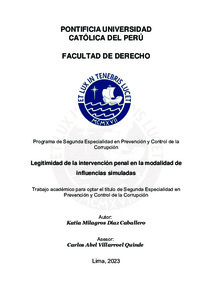Legitimidad de la intervención penal en la modalidad de influencias simuladas
Abstract
El presente artículo analiza como problema principal a la legitimidad de las
influencias simuladas en el delito de tráfico de influencias. Por lo tanto, en la
primera sección describimos las principales características del delito, como la
conducta típica y la consumación del delito. Asimismo, conceptualizamos y se
diferencian sus modalidades; y posteriormente, se elabora un detalle de las
posturas más importantes respecto a cuál es el bien jurídico protegido.
En el segundo apartado comenzamos por brindar alcances del principio de
lesividad, continuamos con el principio de mínima intervención y con lo explicado
analizamos la jurisprudencia y doctrina en relación a la legitimidad de las
influencias simuladas para tomar una postura al respecto de si superan el riesgo
penalmente permitido. This article analyzes the legitimacy of simulated influences in the crime of
influence peddling as the main problem. Therefore, in the first section we describe
the main characteristics of the crime, such as typical behavior and the
consummation of the crime. Likewise, we conceptualize and differentiate its
modalities; and subsequently, a detail of the most important positions is
elaborated regarding which is the protected legal asset.
In the second section we begin by providing scope of the principle of harm, we
continue with the principle of minimum intervention and with what has been
explained we analyze the jurisprudence and doctrine in relation to the legitimacy
of simulated influences to take a position on whether they overcome the criminal
risk permitted.
Temas
Delitos de los funcionarios--Perú
Corrupción política--Perú
Derecho penal--Perú
Corrupción política--Perú
Derecho penal--Perú
Para optar el título de
Segunda Especialidad en Prevención y Control de la Corrupción
Collections
The following license files are associated with this item:






